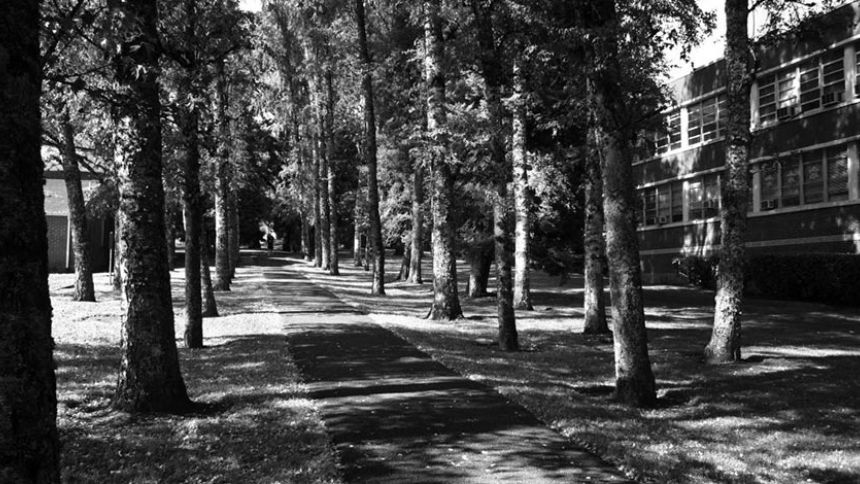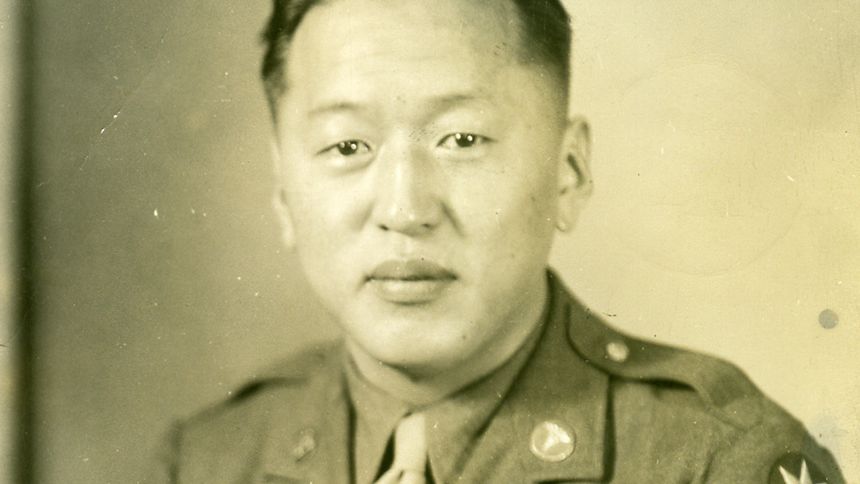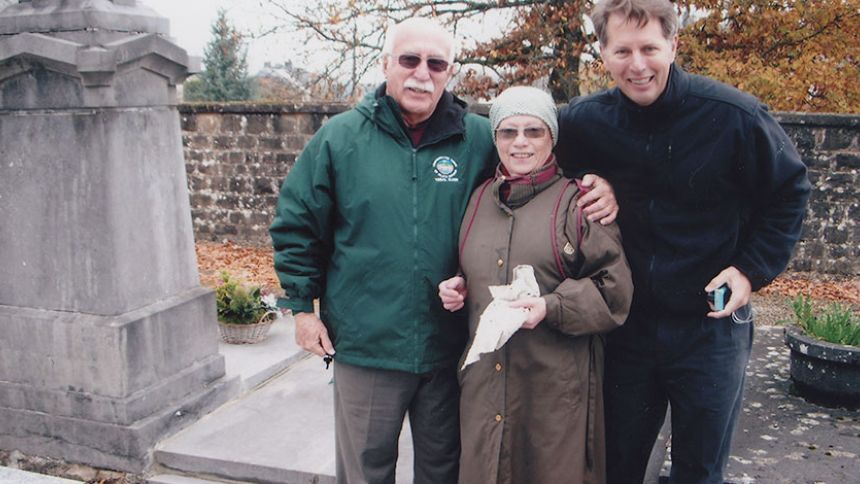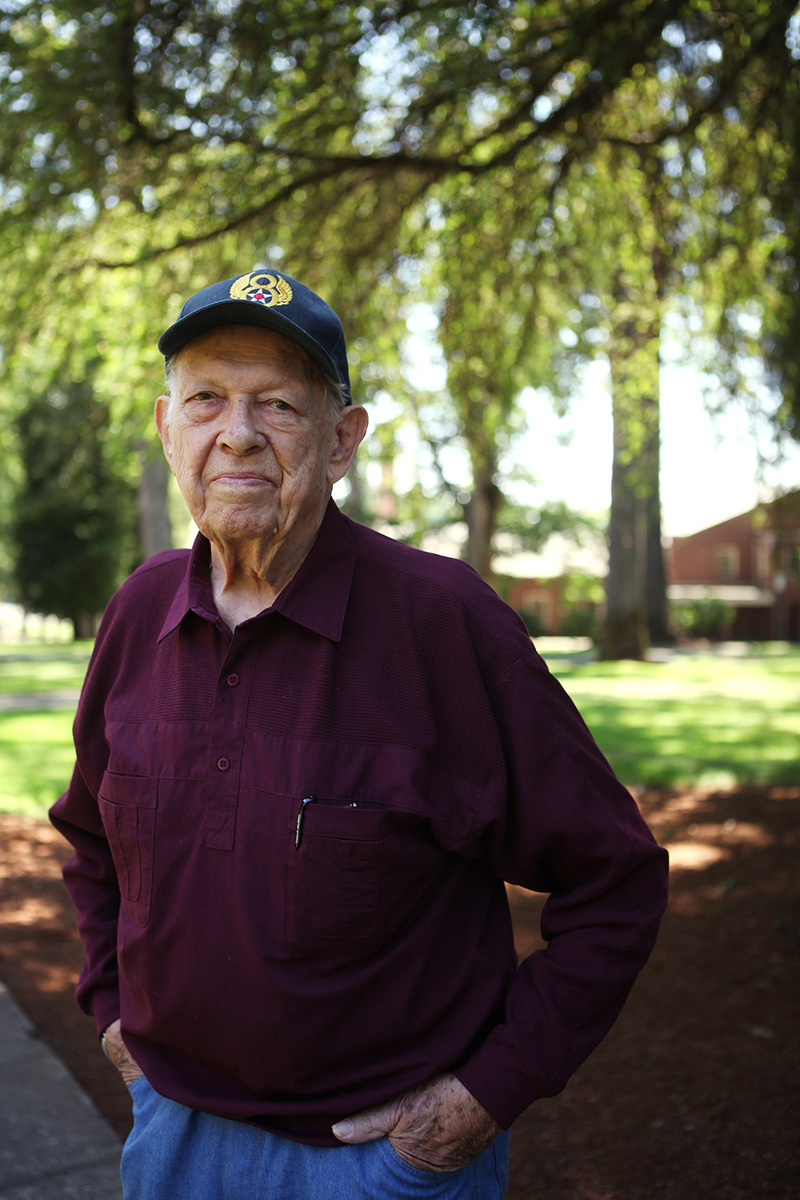
The last time Gruber saw his B-24 bomber he was falling away from it, 18,000 feet above Germany.
But not until 35 years later, through a chance encounter on the Internet and the kindness of strangers in two distant countries, would he learn the complete story of the incident that nearly took his life that fateful day of Dec. 1, 1943.
Gruber came to the tiny town of Silver Lake, a remote outpost in the sage-dotted Oregon high desert, at the age of nine with his mother and father during the early years of the Great Depression. There his parents eked out a modest living operating the general store and after it burned down, a small restaurant.
The principal of the town’s high school, Walter Sherman, was a Pacific graduate. Taking an interest in Gruber, he helped arrange a scholarship to his alma mater, and in the fall of 1938 the young man came to Forest Grove. After undergoing the usual embarrassing initiation rituals inflicted on incoming “rooks” (freshmen) by upperclassmen, he adjusted quickly to the “huge” university. At Pacific Gruber studied under Professor “Hap” Hingston, whose speech, drama and writing classes in Marsh Hall intrigued him. Assigned by Hingston to write short stories, he found he was good at it. It was the beginning of a passion for the communications arts.
Another interest was aviation. In those prewar years, Pacific participated in a government-sponsored Civilian Pilot Training program. Ground school curriculum was taught on campus; flight instruction was given at Hillsboro Airport. Gruber enrolled and soon found himself in a little Piper J5 Cub soaring over scenic Washington County farmland under the expert guidance of legendary pilot and air show star “Swede” Ralston.
Fellow student Maurice “Maurie” Druhl, a cocky, strapping guard on the varsity football team, was taking flight training too. Strikingly different in personality and academic interests, Druhl nonetheless became one of Gruber’s pals, a friendship that would deepen during the war years and endure until Druhl’s death.
Late on a Sunday morning in December 1941, Gruber was walking down the stairs in Mac Hall when news of the attack on Pearl Harbor came over the dorm radio. Gruber was not particularly surprised because the war had been a subject of much debate with many students ardently opposed to America’s entry into a European or Asian conflict. That isolationism died with the first reports of Pearl Harbor. The next day, many students left to enlist.
With an attack on the West Coast now a distinct possibility, air raid drills and campus blackouts became the order of the day. Gruber signed on with the Aircraft Warning Program and spent many nights atop the First National Bank (now U.S. Bank) building in Forest Grove watching for Japanese aircraft.
Soon orders came and he was processed into the Army Air Corps as an aviation cadet. After a rigorous and relentless air and ground curriculum he was assigned as a copilot in a B-24 “Liberator,” a huge four-engined heavy bomber, part of a ten-man crew lead by 2nd. Lt. Horace “Ketch” Ketchum, of San Saba, Texas. “Our crew were all great people and we got along well. Ketch was a good pilot and was my teacher in flying the B-24,” Gruber recalled.
The crew flew to England, where they were assigned to the 93rd Bomb Group, based at Hardwick, about 56 miles north of London, where they were assigned a new B-24D. Painted on its fuselage was a caricature of a kicking mule and its nickname: Iron Ass, a wartime expression denoting a hard-nosed commanding officer. They flew nine missions, some from Africa and some from England, including a harrowing sortie over Austria in which several bombers in their group were shot down, one exploding a hundred yards ahead of them in a huge ball of flame and debris.
Then, early in the morning of Dec. 1, 1943, the 93rd’s combat crews rose in the drizzly predawn darkness for a mission briefing. The target: Solingen, a transportation hub in the Ruhr Valley, Germany’s industrial heartland, heavily defended by flak guns and fighters. The group had gone there the day before but had to abort due to cloud cover over the target. Now it was on again.
After breakfast a visit to the chaplain and briefings by intelligence and weather officers, the crews manned their bombers and began the dangerous takeoff procedure. One by one the big ships rumbled down the runway in the lightening gloom, slowly lifted off and vanished into the clouds.
On emerging above the cloud deck in brilliant sunshine, the group’s 17 B-24s assembled in combat formation behind their leader. Then they joined the other groups in the strike force of 293 heavy bombers and set a course for Germany, climbing slowly to their assigned altitude.
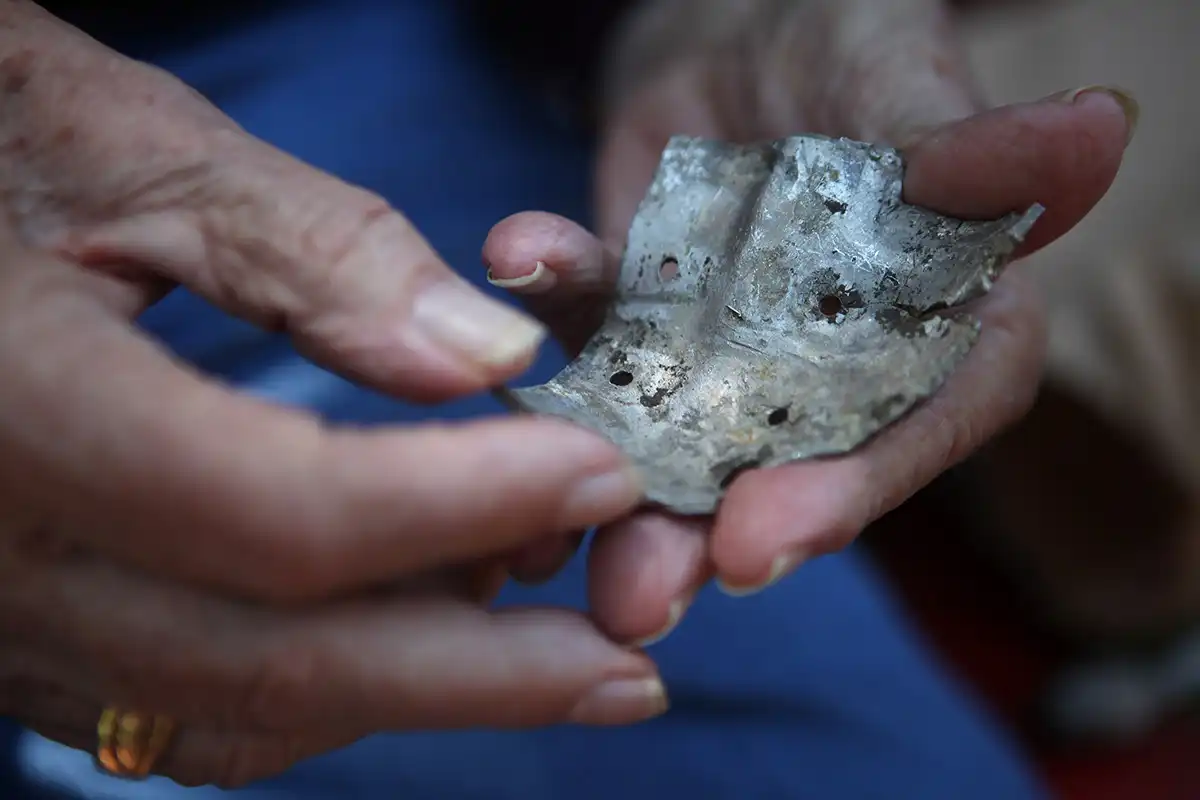
As the long bomber stream passed over Holland, escorting American fighter planes weaved white condensation trails in the deep blue thousands of feet above the formation, a reassuring sight. But soon they reached the limit of their range and turned back. The bombers were immediately attacked by German fighter planes. The bombers’ defensive guns opened fire and a running battle ensued. Iron Ass remained unscathed but as the formation neared the target at Solingen, the propeller on the number three engine suddenly became uncontrollable and was quickly shut down. The heavily loaded plane, unable to maintain formation, began to fall behind.
Now alone deep in Germany at 23,000 feet, the crew was in mortal danger. As they fell away from the formation, another crippled B-24 pulled in close for mutual protection. Gruber could see a lovely pinup girl painted on its fuselage and read her name: Nana. “I vividly remember the plane’s name…” he wrote later, “…how could I forget?” Enemy fighters pounced on Nana, sending her down in flames as the crew of Iron Ass watched. Ten men…incinerated.
Now it was their turn.
The fighters made head-on passes and rear attacks. The shipshook from the impact of 20 mm. explosive shells and vibration from her own guns as the crew fought for their lives. Tail gunner Sgt. Harry Byerman kept firing his twin 50 caliber machine guns until he was killed in an attack that damaged the tail; the waist gunner was wounded in one leg.
In the cockpit, Gruber and Ketch struggled to control the ship. A shell exploded in the left wing, peeling the aluminum skin off the top. Another knocked out the left inboard engine. Ketch’s window imploded, scattering metal and plexiglas fragments in the cockpit. Now down to 18,000 feet, it was time to get out. With a swiftness born of instinct, Gruber grabbed his chest pack chute, ripped his oxygen and intercom connections from their sockets and squeezed down into the bomb bay, the only exit. The doors were closed. He was trapped.
Fumbling in the subzero darkness he somehow found and pulled the emergency lever. The big doors slowly rolled open, revealing solid white cloud far below. Looking up into the cockpit he saw Ketch grab his chute. Then he pushed off into empty sky.
The 160-mph slipstream slammed him hard. He pulled the D-ring and the chute opened, knocking the wind out of him. Suddenly, all was quiet. Gone were the roaring engines, screaming on the intercom and blasting guns. He hung suspended in space over a cloud deck three miles down.
The crippled bomber, propellers on two of its four engines still turning, began the long, slow fall into Germany, harried by the pursuing fighters. Then it disappeared.
As Gruber came out beneath the clouds, a snowy landscape rushed up to meet him. He hit with tremendous impact, fracturing an ankle. Though hobbled, he managed to escape capture until climbing a ridge he emerged into an open field, face-to-face with a civilian who aimed a shotgun at him. The “hands-up!” order in German needed no translation.
Gruber’s flight mates were also captured and the group was sent to Stalag 1, a bleak compound of barracks surrounded by barbed-wire fences and towers. Finally, in the last days of the war, they were “liberated” by Russian troops who kept them prisoner until a U.S. Army medical team arrived with news that they would be airlifted out in U.S. aircraft. A month later, after a slow transatlantic crossing on a Victory ship, the freed prisoners saw an unforgettable sight loom on the horizon – the Statue of Liberty!
World War II ended with the Japanese surrender on Sept. 2, 1945. The nation rejoiced. Soon afterward Gruber was discharged from the Army Air Force and reenrolled at Pacific on the GI Bill, graduating in the spring of 1947 with a bachelor’s degree in business administration.
Though the postwar job market was tight, Gruber landed a job with KOAC radio in Corvallis. Over the next five decades he would work as a staff announcer at KOIN, a top Portland station, as executive director of the Oregon Museum of Science and Industry and as deputy director of the Oregon Department of Veteran’s Affairs. While holding down civilian jobs he served in the Air Force Reserve and Oregon Air National Guard, retiring with the rank of Lieutenant Colonel.
"You must know that without people like you we are still in the darkness. What we do is very little compared to the risk you and your friends [took] that bloody day for people you really don’t know who are mostly ungrateful to your country…You do it for Laetitia and all the children who can play in the snow without fear."
Phil Dufresne
As the years rolled by, the rest of the crew of Iron Ass passed away one by one. In the autumn of his life now well into retirement, Gruber was the last survivor. He still sometimes thought about the plane in which they had flown their final mission, but with the others gone he had mostly laid it to rest, until… one day in 1998. Gruber was on the Internet reading the B-24 Veterans’ Group website. As he casually scanned the postings he stopped suddenly at one that read: “Hello to all. Does anyone have some information about the B-24D, nickname ‘Iron Ass”, Serial 42-40-769, lost the 1st of December, 1943? Thank you.”
The cryptic message was from Phil Dufresne in Brussels, Belgium, a history buff, one of many private citizens in Europe who volunteer their time to locate and document World War II aircraft crash sites. Stunned, Gruber tapped out a reply: “Hello Phil. I was the co-pilot on Iron Ass, shot down 1 December, 1943. Target Solingen. What is your interest? Do you know the crash location?…”
In a few hours an answer came. While making a list of aircraft lost over Belgium during the war, Dufresne had come across one incident that didn’t quite fit. A B-24, supposedly downed over Belgium, had, he believed, actually crashed in Germany. The aircraft in question was Iron Ass. Over the following months Dufresne and fellow researcher Eric Mombeek spent countless hours and considerable personal funds to track the last moments of Gruber’s B-24. Their informal network often solves cases of lost airmen and aircraft on both sides, valuable work that can help bring closure to relatives.
Then came a surprise. A contact of Dufesne’s in Germany, Wolfgang Meyer, had located actual remains of Iron Ass near the small village of Eicherscheid, south of Cologne. Gruber read Meyer’s e-mail: “The aircraft…exploded still in the air over the town, four kilometers south of Bad Munstereifel…Most of the parts fell in the town…in private gardens or parcels. Nevertheless, a larger part of the aircraft including parts of a wing as well as an engine, [fell] in a wood and I could find some pieces last year.”
In the summer of 1999, Dufresne, his wife Claudine and five-year-old granddaughter Laetitia, visited Gruber at his home in Beaverton. Dufresne brought a suitcase of excellent Belgian beer and a package of recovered parts from Iron Ass. The pieces were carefully laid out on a picnic table in the back yard. As Gruber examined some of them he thought about what they meant, about his crew, and wondered at the kindness of strangers.
Months earlier he had tactfully offered to send Dufresne some money to reimburse his research expenses, which were adding up to a considerable sum.
Dufresne’s response read: “Hey Gruber, we are friends now, don’t ask again that you want to pay for something…You must know that without people like you we are still in the darkness. What we do is very little compared to the risk you and your friends [took] that bloody day for people you really don’t know who are mostly ungrateful to your country…You do it for Laetitia and all the children who can play in the snow without fear. I never thank you enough and I am proud to be your friend.”
Clinton Gruber died in March 2011, but he remains forever a part of the Pacific University community.
